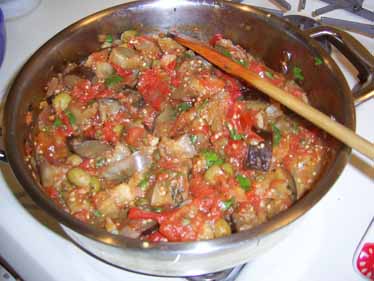
On Saturday afternoon I was home alone with two beautiful shiny eggplants, one deep purple and the other silky white.
(Can I just say I cannot believe that today is Thursday, and only now am I writing about what I did on Saturday? Need. More. Time. Please!)
OK, enough of the breakdown, let’s get back to the eggplants. I had bought them at the farmers’ market the previous weekend, and they had been languishing in the refrigerator all week. These spongy vegetables needed to be cooked and consumed, fast. I could have made Pasta alla Norma again, but I decided to go the carb-less route and make some Sicilian caponata.
The recipes for both dishes are pretty similar, but I like to think of caponata as Norma with a Mediterranean kick, its flavors intensified by the addition of vinegar, capers, and olives. Eaten at room temperature as an antipasto or side dish, the caponata would be a sly addition to the junk food we’d enjoy during the Steelers game on Sunday. Could it break past the pretzels and beer to win acceptance as football fare? The odds were not in my favor.
After chopping both eggplants and sautéing them in olive oil until they browned, I gradually added the rest of the ingredients and let everything simmer for a while. As the pan cooled, aromas of tomatoes, acidic red wine vinegar, and salty capers intermingled above the stove.
Finally I heaped a pile of the saucy, wonderful mess onto a cracker and bit in. Chunks of eggplants fell off the cracker and onto my plate, but I did manage to guide some of the caponata into my mouth. Flavors of salt and brine spread over my taste buds, but the eggplants had still retained their creamy firmness.
The next day I casually served the caponata during the game. Our friend Diego’s initial “I’m not that fond of eggplant,” turned into “Hey, this is pretty good.” I guess sometimes there is room for something new, even during a football game. We’ll see what else I come up with this season.
Recipe for Caponata (Adapted from Jamie’s Italy)
- Extra-virgin olive oil
- 2 eggplants, any color you like, chopped into medium chunks
- a large handful of fresh basil, minced
- half a medium red onion, chopped
- 2 cloves garlic, minced
- a small bunch of parsley, leaves picked off, stems chopped
- 2 tablespoons salted capers, rinsed, soaked, and drained
- a handful of green olives, pits removed
- 2 tablespoons red wine vinegar
- 5-6 large tomatoes, roughly chopped. Half of the tomatoes can be cored, seeds removed
Heat some a few tablespoons of olive oil in a large pan. Add the eggplants and basil and sauté for a few minutes, turning often, until the eggplants brown. Add the onion, garlic, and parsley stems and cook for a few minutes. (I have to say, Oliver’s frequent use of herb stems in his recipes is brilliant. They add so much flavor to the dish). Add the capers, olives, and the vinegar. When all the vinegar has evaporated, add the tomatoes. Cover and simmer for about 15 minutes, so that the tomatoes soften. If the dish seems too watery when you take the cover off, simmer a little longer until some of the liquid evaporates. Once the dish cools, sprinkle the parsley leaves and olive oil over it. Serve with crackers or crusty bread. It will keep for about two days in the fridge. I warm the caponata up in the microwave to take the chill off. I also recommend sprinkling it with olive oil each time you serve it. Enjoy!






 Subscribe to the Choke
Subscribe to the Choke 
